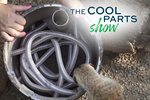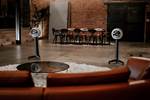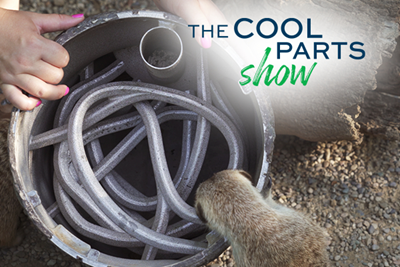For the audiophile, the best speaker is one that conveys the fullest range of sound possible. But conventional box-style speakers have to be large to preserve the bass range of the sound they deliver, and the resulting size can make them awkward and inconvenient to own. These speakers also suffer from a flaw in their design: corners. Corners create dead zones where sound is lost, so even the best box speaker can’t convey sound as efficiently as possible.
Node Audio has developed a different type of high-fidelity speaker, one that can both move sound efficiently and preserve its full range within a small package. The Hylixa speaker features a rounded 3D printed cabinet that avoids corners altogether and features a complex internal geometry that allows sound to move through unhindered. Learn how it was created in this episode of The Cool Parts Show. | This episode of The Cool Parts Show brought to you by Carpenter Additive
The Cool Parts Show is a video series from Additive Manufacturing Media that explores the what, how and why of unusual 3D printed parts. Watch more here.
Have a cool part to share? Email us.
Resources and Links
- More about Node Audio
- More on how and why Node Audio’s founders developed the Hylixa speaker
- 3D Systems S-Pro 60 SLS system and DuraForm GF material
- Basics of Selective Laser Sintering (SLS)
Transcript
Stephanie Hendrixson
In this episode, we'll talk about why corners are the problem you never knew you had, and see what happens when two industrial designers literally think outside the box. Welcome to The Cool Parts Show.
Peter Zelinski
The Cool Parts Show is brought to you by Carpenter Additive. The company's Athens Alabama Emerging Technology Center is an end-to-end additive manufacturing production facility with everything from material development, to postprocessing under one roof, ready to help you with your next metal 3D printing job. Check them out at Carpenter Additive.com. Now back to the show. I'm Pete.
Stephanie Hendrixson
I'm Stephanie.
Peter Zelinski
Welcome to The Cool Parts Show. This is our show about parts manufactured through 3D printing, we talk about new stuff becoming available to us because of 3D printing. We talk about 3D printing and the meaning it's going to have for the future of manufacturing, and speaking of future, it looks like you brought us a dinosaur egg.
Stephanie Hendrixson
That's right, 3D printed dinosaur egg, that's our part today. Just kidding. this is actually a speaker cabinet. This is for a high-end consumer product, the Hylixa speaker from Node Audio, and this speaker solves a problem that I didn't even know speakers had. It has very few flat surfaces and basically no corners.
Peter Zelinski
Speakers typically they are like cabinets, they're box shaped they have corners, I never realized that was a problem. Why are corners a problem for sound quality?
Stephanie Hendrixson
It's a problem because anywhere you have a corner is basically a place that the sound can kind of get trapped. If you think about being in a room with the rotunda versus one with a flat ceiling, the way that the sound moves is different, it's going to go farther, it's going to sound louder, and it's the same kind of idea here. Actually in use, the speaker would be like this facing that way, and you can see that it has kind of this like spiral on the inside. That means the sound can move through without hitting any corners. I want to introduce you to the people who created this part, the cofounders of Node Audio to industrial designers. This is Ashley May and David Evans.
Ashley May, Node Audio
In scaling down a speaker, you lose a lot of the bass performance that you get from a large square cabinet, but these large square cabinets are also acoustically compromised. We wanted to arrive at a solution that was acoustically far superior to what had gone before. A good example, with a square cabinet is that you get resonances from the structure, so the panels vibrate, standing waves form in the panels, and that gives a certain coloration to the sound, a negative coloration. Also the square corners of cabinets that creates a smearing and a type of diffraction, which negative because of sound, particularly in the vocal region, I mean we don't have square heads right, we've got rounded head. So when the voices and sound leaves our mouth, it flows around our head in a particular way, and you can only achieve the accuracy and realism by replicating that sonic signature of around head. That was our starting point, but in doing so you compromise the bass performance because you've come from a large cabinet, which is really good at producing bass to something quite small and limited in the bass range. We set about figuring out how can we recover that bass performance, and that led us to a special acoustic geometry called a transmission line, which isn't a new theory. It's a way of extracting more bass performance from a cabinet, but the only way to get this long acoustic transmission line, which is essentially a path for a long acoustic channel inside the cabinet, was to coil it up in a sort of almost like a seashell shape.
David Evans, Node Audio
That's true, I mean it was obviously driven by the sort of function initially, but as designers, obviously we wanted to make this product looked as good as it sounded as well.
Peter Zelinski
It sounds better because it's shaped like my head?
Stephanie Hendrixson
That's a big part of it, but to really get everything that Node is after you need more than the round shape, you need that helical transmission line, the spiral on the inside to get as much sound range out of a speaker this size.
Peter Zelinski
How did they know that? How did they know spiral on the inside? How do they know this is the right design?
Stephanie Hendrixson
Good question. Ashley and David worked with an acoustical engineer who was actually able to simulate how the sound would move through the different design iterations. They use that simulation alongside the prototyping process.
Ashley May
There's some really excellent acoustic software out there that can give you a really good handle of what's happening in reality before you even press go and print a prototype, but what the prototypes are great for were validating those acoustic simulations. We actually made some really interesting discoveries by altering the prototype, and then feeding that back into the acoustic simulation.
David Evans
The entire sort of development stage of the product was probably, I think it was three years in total. That was, like Ashley said, initially working with an acoustic engineer to simulate that design, and then pulling back towards to then prototype or tweak the design before we went into production.
Peter Zelinski
That's really wild. We've done episodes before about 3D printed parts where their form was optimized for forces, and loads here is a part optimized for invisible soundwaves. How was this 3D printed?
Stephanie Hendrixson
This was 3D printed with selective laser sintering. So SLS, specifically on an S pro from 3D Systems, and I actually have another part here that was made the same way, and this is kind of like the front face of the speaker. Both of these parts are made out of a material called DuraForm GF. It's a polymer composite, it's glass-filled nylon, but it really doesn't feel like plastic, it has kind of like that ceramic quality to it. It's really heavy, solid, dense, and they chose it because it's not a very resonant material. If you kind of knock it, there's no ring to it, the sound just kind of falls flat, and that is actually what you want out of a speaker like this, because that means the sound isn't vibrating the cabinet, the sound is moving through the cabinet out into the room.
Peter Zelinski
This is so cool, I'm totally in. They use the design freedom of 3D printing, and it wasn't just geometric freedom, they got this form that's adapted to the acoustics, but they also employed the material freedom. The freedom to choose exactly what material they wanted to print with, and the right material in this case was this really dense, kind of ceramic like material that is has great acoustic properties and no resonance.
Stephanie Hendrixson
I guess we should say, this is not the entire product, there are other parts that go with this. There are other 3D printed pieces, there are machined pieces, there's the electronics, and actually the parts we have here are not even finished. There's a lot of postprocessing that goes into this, the cabinet is kind of the key, but it's sort of just the beginning.
Ashley May
A good example is the head of the speaker. The rounded part that you have there, black cabinet, it builds great, it's got fabulous acoustic properties, but when it comes off the machine, it's got that kind of grainy finish. There are certain processes where you can smooth it, I'm sure you probably know about vibro-polishing, but nothing really gets that finished at certain level that we're after that justifies the price of the speakers and matches the acoustic quality. So we thought, well hang on a minute, if we separate the components so the next section of the cabinet is actually a separate piece, and then we build the cabinet head oversize by a few mil on the outside, we can then put that part into a CNC lathe, and we can cut that part back to the finished accurate dimensions so that when it goes off to the paint finisher, they've got a really good base surface to start their sanding and painting process. It was putting in a few automated steps before it went to the manual finishing to really save a bit of money and actually achieve a better finish.
Peter Zelinski
They're machining this, and I wouldn't have expected that you'd machine this kind of ceramic key polymer material. Does the fact that they know they're going to machine affect anything about the way they design it?
Stephanie Hendrixson
Yeah, so aside from printing it a little bit larger to accommodate for that finished machining, there are a couple of design tweaks. Right inside of this cabinet, on kind of the inner diameter, there are these little ribs. That's one example.
Ashley May
Obviously every part from here, so this machine are very, very slight tolerance differences. The aluminum mandrel that fits inside the mouth of the speaker, and our engineer offers that up to each cabinet and we built him very small ribs internally so that he can tweak them and file them down so this mandrel fit beautifully snugly inside the cabinet. Otherwise he'd be tackling a large surface back, so it's just making intelligent use of those details to give the engineers and the assembly guys the right tools, and the right processes to really make it efficient to mounted onto the CNC lathe.
Peter Zelinski
I think I got this, so audio speakers, we're used to them being cabinets, we're used to them being boxes, but the corners in those boxes were costing us something that's not the ideal form for sound quality. The ideal form for sound quality, something more like this. Egg shaped but also with this seashell spiral on the inside that transmits the sound, that spiral in this form were designed with the help of an acoustic engineer able to model just the right form for that sound quality, a sound realized through 3D printing. This was 3D printed through selective laser sintering on a machine from 3D Systems and the material is important to. This dense, low resonance, glass filled nylon is important to the sound quality as well, material and form both contribute to the quality of the sound. It's a work of art in addition to being an audio speaker, it's got to look good in the setting it's going to be used in. That affects the postprocessing considerations, and one of the ways that this is postprocessed or a part like this will be, to get a really smooth finish is through machining, and they even design some features into this that aid in that machining. I think all that still leaves one question unaddressed. We've just got the part here. We don't have a finished speaker. How does this sound?
Stephanie Hendrixson
That is a great question. This speaker has been on the market since 2019. I've never had the pleasure of hearing it in person. I asked David and Ashley if they could describe what it sounds like.
David Evans
In terms of a clarity, soundstage, it's quite again, a cheesy sort of comment to make, but it's as though the artists is in the room with you. It just sounds like a live performance.
Ashley May
Really what we're after is an emotional response, and it's really lovely. We've got a listening room here, and when you sit down, if you've never heard it before, it's great to watch their faces, and see their first reaction when they listen to a track they've heard thousands of times. When they listen to it on this system, there's all these details and nuances, and a level of realism they haven't actually heard before. So it's almost like listening to their favorite track for the first time again, and that's quite a nice thing to experience.
Stephanie Hendrixson
Alright, so possibly coming soon to a living room near you. That's it for this episode of The Cool Parts Show. If you'd like to learn more about Node Audio and the speaker, you can find a link to the story in the description below. If you have a cool part you'd like to tell us about email us, Cool Parts at additivemanufacturing.media.
Peter Zelinski
Watch more of The Cool Parts Show. You'll find our episodes on YouTube or at The Cool Parts Show.com and don't forget to subscribe.
Stephanie Hendrixson
Thanks for watching.
Peter Zelinski
Thank you to our sponsor Carpenter Additive. Listen to additive manufacturing podcasts, attend webinars and learn more at Carpenter Additive.com
Related Content
How to Build 10,000+ Shot Molds in Hours
Rapid tooling isn’t so rapid when it takes days to 3D print a metal mold, and then you still must machine it to reach the necessary tolerances. With Nexa3D’s polymer process you can print a mold in hours that is prototype or production ready and can last for more than 10,000 shots.
Read MoreMultimaterial 3D Printing Enables Solid State Batteries
By combining different 3D printing processes and materials in a single layer, Sakuu’s Kavian platform can produce batteries for electric vehicles and other applications with twice the energy density and greater safety than traditional lithium-ion solutions.
Read MoreAluminum Gets Its Own Additive Manufacturing Process
Alloy Enterprises’ selective diffusion bonding process is specifically designed for high throughput production of aluminum parts, enabling additive manufacturing to compete with casting.
Read MoreAdditive Manufacturing Is Subtractive, Too: How CNC Machining Integrates With AM (Includes Video)
For Keselowski Advanced Manufacturing, succeeding with laser powder bed fusion as a production process means developing a machine shop that is responsive to, and moves at the pacing of, metal 3D printing.
Read MoreRead Next
3D Printed Animal Enrichment Device: The Cool Parts Show #22
The Cool Parts Show goes to the zoo to learn about a 3D printed enrichment device being used to challenge and engage meerkats, birds, foxes and more in this bonus episode.
Read More3D Printed Speaker Cabinet Delivers Big Sound in a Small Footprint
Node Audio’s Hylixa high-fidelity speaker takes advantage of selective laser sintering (SLS) 3D printing to achieve a compact construction with an uncompromised sound range.
Read MoreAerospace Manufacturer Pivots to 3D Print Masks for COVID-19 First Responders
Rapid Application Group is finalizing a 3D printed mask to protect first responders and medical staff who may be exposed to coronavirus. The nylon mask uses a replaceable N-95 or HEPA filter.
Read More

.jpg;width=70;height=70;mode=crop)













